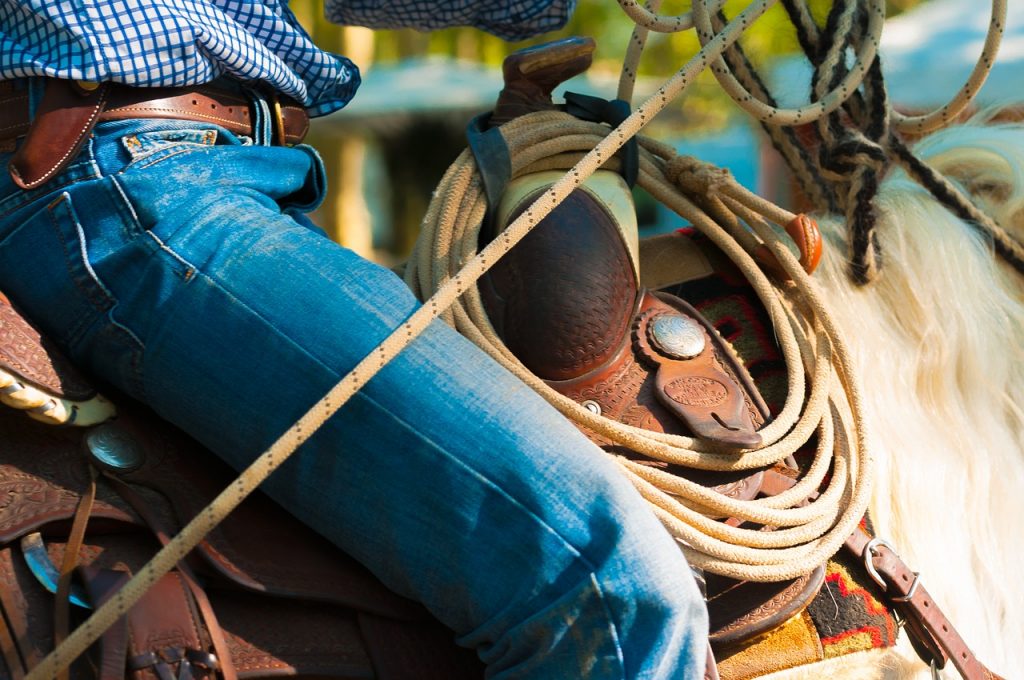The Great American Blue Jean Posted by Gary Locke on Mar 29, 2018 in Culture, English Language, English Vocabulary
Spoiler alert: It’s only partly American.
They have been called the world’s most popular article of clothing. According to the latest statistics, almost 1.25 billion jeans are sold worldwide each year. They have been immortalized by cowboys, greasers, and rock stars. World leaders wear them, as do children. We know them also as dungarees and under several popular brand names such as Levis, Wranglers, and Lees. They also serve as iconic emblems of Americana. But, don’t be misled. Like so much of America, your blue jeans emigrated here from other parts of the world.
When Jacob Met Levi
The story goes that a woman walked into the Reno, Nevada dry goods store owned by Jacob Davis in 1871 looking for pants for her husband who was a gold miner. The wear and tear (quite literally) on her husband’s clothing was so bad that his trousers were in tatters after just a few weeks. Couldn’t Mr. Davis make something that would withstand the rigors of her husband’s work?
Davis began making pants from brown canvas, called duck cloth, but he added the rivets from harnesses for horses to help strengthen the stress points of the trousers. It was precisely the addition that was needed, and the riveted pants were soon the fashion of all hard-working miners in the area. Cowboys also began to buy the trousers, because they withstood the rigors of being in a saddle all day. It didn’t take long for Davis to realize that he had a valuable product, and he needed to protect his innovation. Davis turned to a wholesale supplier in dry goods who could provide all the materials and workers needed to keep the business thriving, and who also would provide the capital necessary to acquire a patent. His name was Levi Strauss.
Strauss was an immigrant from Bavaria. Strauss’s family business was centered in New York and run by his brothers but, seeing the potential in the American expansion westward, Levi opened shop in San Francisco just as the California Gold Rush was at its peak in 1853. He had found moderate fortune, and was expanding the family business, but his remarkable success came when Jacob Davis contacted him looking for a partner. On May 20, 1873, Davis and Strauss took out a patent for riveted, brown duck pants.
The canvas material that Davis and Strauss’s trousers started from was highly durable and water resistant. It was also heavy and stiff. Was there another material that was more flexible, lighter weight, and yet equally as rugged? As a matter of fact, there was. And it had been around for a long time.
The Etymology of a Fabric
Clothiers in Genoa, Italy had been making a fustian, or heavy cotton cloth, since the early 17th century for sailors. It was made to wear wet or dry, was inexpensive, and proved to be the perfect working man’s material. French weavers in Nîmes, France tried to replicate the material from Gênes (the French word for Genoa) but succeeded in creating something with a little more twill. Still, the fabric was tough as well as soft. The trousers made from it came to be known as Gênes di Nîmes. Eventually, this was Anglicized as denim jeans.
A version of the same material appeared nearly simultaneously in Bombay, India. Because trade was international, it is hard to know which came first, but the blue-dyed fabric of Bombay was the standard cloth of the working poor who toiled dockside in the village of Dongri. The cloth was called dungri in Hindi and found its way to the docks of England. There were stories, probably apocryphal, of workers finding dung beetles in the cloth. In any case, the name for the blue cloth of the working poor stuck – dungarees.
When Strauss, against the objections of Davis, sought a lighter fabric from his family’s import firm in New York, they sent him the blue dungaree cloth. For many years the brown duck material was sold concurrently with the softer blue fabric but, by 1890 when the original patent expired, the Levi 501 blue jean with its five pockets (including one for a pocket watch) was the standard by which all would later be judged.
Tramps Like Us
In the 1950s the blue jean, long the fashion for hard-working laborers, became the symbol of fashion and cool when movie stars like James Dean and Marilyn Monroe could be seen wearing them everywhere. Later, of course, the hippie movement embraced jeans with embroidery and patches. And, of course, they became the permanent fixture for the young and young-at-heart thanks to the cover of Bruce Springsteen’s album, Born in the U.S.A.
How many pairs have you owned?

Build vocabulary, practice pronunciation, and more with Transparent Language Online. Available anytime, anywhere, on any device.




